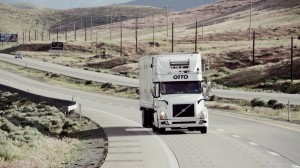
Newly proposed emissions rules for semi trucks and heavy duty trucks call for significant cuts in emissions.
The push to make passenger vehicles more environmentally friendly spilled over to heavy duty and semi trucks today as federal regulators proposed new emissions standards and goals for those vehicles today.
The new regulations issued by the U.S. Environmental Protection Agency and National Highway Traffic Safety Administrationaim for a 10% overall reduction in greenhouse gases.
“Manufacturers are innovating and developing new technologies at a faster pace than we expected,” said Dan Utech, deputy assistant to President Obama for climate change and energy.
“We believe these standards will result in a 1.1 million-ton reduction in carbon emissions over the period they take effect.”
The new standards come after a year of comment and input from industry officials, suppliers, environmentalists and the public. Comment from the public is important because it’s not just those long-haul trucks that are impacted by the new rules.
Ford Super Duty, Chevy Silverado HD, GMC Sierra HD and Ram’s 2500 and bigger heavy duty trucks are part of the new mandates. Those vehicles would have to see a 2.5% boost in fuel economy each year during the same six years.
However, the new rules are tougher on the aforementioned semi trucks, which account for about 60% of total greenhouse emissions and fuel consumption at present in the heavy-sector would need to achieve up to a 25% reduction in fuel economy and greenhouse-gas emissions from 2021 to 2017.
Not surprisingly, many groups were pleased with the proposed standards.
(Dodge unleashes two new beasts in time for Woodward Dream Cruise. Click Here for the story.)
“We urged the agencies to set standards that would achieve meaningful fuel economy improvements and significant consumer savings, and we got them,” said Jack Gillis, CFA’s Director of Public Affairs and vehicle expert.
“For a long time, an efficiency gap has forced consumers to pay the freight for inefficient shipping. These standards will save consumers money, just as other energy efficiency goals have saved families and businesses money on the total cost of owning and operating cars, light-duty trucks, and home appliances such as refrigerators and water heaters.”
U.S. Environmental Protection Agency Administrator Gina McCarthy said that the standards will force fleet operators to invest in their fleets to meet the new standards. However, she suggested that tractor-trailers should recoup those costs in about two years while owners of large pickup trucks and vans should achieve payback in about three years.
The Owner-Operator Independent Drivers Association estimates that additional cost at an average of $14,000 per truck.
(What’s New for 2017? Click Here to check out the latest models.)
Several trucking executives offered their approval of the new standards, which they had a role in shaping during latest phase of the process.
“Our goal in this process was to work collaboratively with the agencies to simplify compliance while maximizing environmental benefits and overall cost savings for the fleets. I think we’ve achieved that,” added Dick Giromini, president and CEO of Wabash National.
“As the innovation leader in our industry, Wabash will continue to pursue new technologies and develop new aerodynamic solutions to further improve fuel efficiency, reduce the operating costs of our customers, and work to develop practical solutions that benefit all stakeholders.”
The new fuel economy and emissions standards for engines, trucks, and trailers will save medium- and heavy-duty truck owners $170 billion over the life of the rules, the agencies calculate. The standard will be applied to vehicles ranging from pickup trucks to big-rig tractors, including 18-wheelers, sanitation trucks, buses and other commercial vehicles, manufactured in model years 2019 through 2027.
(To see more about the potential charges against VW from the Justice Department, Click Here.)
Over the life of the Phase II rule, more than 1 billion metric tons of CO2 and 2 million barrels of oil per day by 2027 will be saved.
